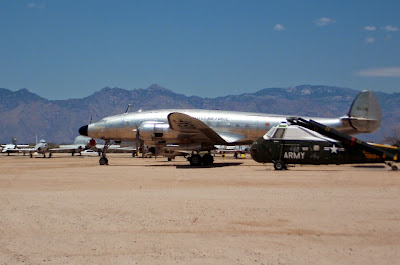The Pima Air and Space Museum had three Lockheed Constellations, each one a work of aviation art.
The first was the EC-121T, but it was in the Restoration area and I couldn't get any closer than this fence behind it.
This one in S/N# 53-0554. From behind, you can get a good view of her lower radar array, and of course that distinctive Connie triple tail.
The second one, # 42-94549, is on display outside as a Trans-World Airlines passenger plane. An L049, she was one of the first twenty-one Constellations originally meant for the military but surplussed off at the end of World War Two. Using these, TWA began New York to Paris flights in February of 1946.
As you can see, I was able to get up close and personal with this one for a bit, and her underside provided some nice shade and a respite from the 110-degree heat. The heat is also why these pics are "camera phone quality". By this time out in the heat, my regular camera had already overheated and shut down and it wouldn't power back up until I got it back in the air conditioning later.
Love that triple tail, even if I can't get in a good position to photograph the whole thing.
Have you ever seen a more graceful looking aircraft?
These aircraft had some history as aviation record-setters. On April 17, 1944, the second production Constelation, piloted by Howard Hughes and TWA president Jack Frye, flew from Burbank, California, to Washington, D.C., in 6 hours and 57 minutes at an average speed of 330.9 mph. On the return trip, the aircraft stopped at Wright Field to give Orville Wright his last flight, more than 40 years after his historic first flight. Wright commented that the Constellation's wingspan was longer than the distance of his first flight.
Third one has some individual history to her. C-121A #48-0614 was one of three such aircraft used as an executive transport for Dwight D. Eisenhower.
Better knows as "Columbine" and graced with decorative nose art depicting the flower, this was the first of Ike's three aircraft.
The third such transport, Columbine III, is on display at the Wright Patterson museum in Dayton, Ohio. As for number two...well it's fate is still in limbo today as it sits in a field out in Arizona.
And there's that tail again.
It's well known that the Lockheed Constellation was the first aircraft of it's type in which two pilots were mandatory at all times. The reason for that is, of course, that not even the hottest military aviator could handle three pieces of tail at the same time.
Thank you...I'll be here all week.












I flew on a Connie from Oakland Army Base to Honolulu as a PVT E2 in 1955 to report to the 25th Infantry. As I recall, it was a Navy plane, and the seats faced the rear of the plane. It was a very comfortable ride, given the circumstances.
ReplyDeleteThe core group of guys I hunted pheasants with in the 1990s were retired captains and flight engineers who'd begun their civilian airline careers fyling Connies. Great stories.
ReplyDeleteThank-you for sharing these pictures and story.
ReplyDeleteI learned something new
I was lucky enough to see theMATS L049 fly a few times before it was sold off to Korea as a gate guard.Sad fate for a flying Connie. I toured inside it at an airshow in Geneseo quite a few years back, sat and talked to an old pilot that had quite a few hours in them...They flew that Connie off a grass airstrip at that show...When I was a kid I lived in Bethesda Md, on the approach toNational Airport.Used to see DC3s, DC 6s and 7s, and of course Constellations flying in..Sure do miss that. 737s, and Hairbuses just are not the same... I still look up though.
ReplyDeleteGood birds... :-)
ReplyDeleteGreat article. Totally accurate, as far as I could tell. With the exception of that last statement!
ReplyDeleteI always thought they were the most beautiful piston-engined airliner of all time.
ReplyDeleteThanks for the photos of these great planes.
ReplyDeleteI rode on a Navy C-121 in October 1969 fro Boling Field DC to Mc Murdo Antarctica (Williams Field). Stops along the way: Camarillo CA, Honolulu, Pago Pago and Christchurch NZ.
Returned I February 1970 aboard another C-121, the Phoenix.
In later years both crashed in Antarctica where they still remain. Fortunately I don't believe that there was any loss of life in either incident.
Stump Jumper
The "Connie" was used as an airliner when I was a child. I never road on one but I remember seeing them at the airfield.
ReplyDeleteI was wrong about the Phoenix - it was another Connie, operated by the Naval Oceanographic Office's Project Magnet, that crashed at McMurdo.
ReplyDeleteThe Phoenix was scrapped after it was decommissioned.
John in Philly
ReplyDeleteMy first flight was in the mid fiftys (I was three, I don't remember it) and my Dad said it was on a Connie. We went from Philly to El Paso to visit my father's family, and to show off the before mentioned three year old.
There is a Super Connie dressed in a West Virginia ANG paint scheme in Udvar-Hazy.
Side note. When the storm passed through a couple of days ago, it converted our canvas topped gazebo to a much more open and airy structure.
Take care,
John
A beautiful piece of aviation history, thanks for posting it.
ReplyDelete